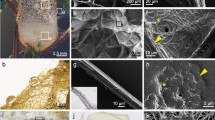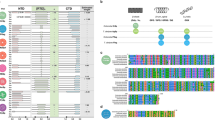Abstract
THE use of a snare woven from spun silk as a means of capturing prey is the most outstanding achievement of spiders. Fossil spider spinnerets are known from the Devonian1 and Carboniferous2 periods. Presented here, however, is evidence of the antiquity of the use of woven silk in prey capture: spider fossils showing morphological adaptations for web weaving, from the Lower Cretaceous lithographic limestone of the Sierra de Montsech, north-east Spain. Reflected light microscopy reveals details of the pattern and structure of the tarsal claws, which were adapted for the handling of silk and locomotion on a web. As only two Mesozoic spiders, Jummneus and Jurarchaea from the Jurassic of the Soviet Union3, have been formally described, the four specimens reported here are an important addition to the fossil record. These belong to three new genera placed in the modern superfamilies Dinopoidea and Araneoidea. Members of both superfamilies weave orb webs or orb-web derivatives4. The Montsech spiders preyed on the abundant insect life which is also preserved in the Cretaceous lithographic limestone5.
This is a preview of subscription content, access via your institution
Access options
Subscribe to this journal
Receive 51 print issues and online access
$199.00 per year
only $3.90 per issue
Buy this article
- Purchase on Springer Link
- Instant access to full article PDF
Prices may be subject to local taxes which are calculated during checkout
Similar content being viewed by others
References
Shear, W. A. et al. Science (in the press).
Petrunkevitch, A. in Treatise on Invertebrate Paleontology, (ed. Moore, R. C.) 42–162 (Geological Society of America and University of Kansas Press, 1955).
Eskov, K. Neues Jb. Geol. Paläont. Abb. 175, 81–106 (1987).
Shear, W. A. in Spiders—Webs, Behavior, and Evolution, (ed. Shear, W. A.) 364–400 (Stanford, California, 1986).
Lacasa, A. & Martinez, X. Paleont. Evoluc. 20, 215–223 (1986).
Barale, G. et al. Geobios, Mém. spéc. 8, 275–283 (1984).
Schairer, G. & Janicke, V. Neues Jb. Geol Paläont. Abh. 135, 171–189 (1970).
Brenner, P., Goldmacher, W. & Schroeder, R. Neues Jb. Geol Paläont. Mh. 513–524 (1974).
Selden, P. A. Palaeontology (in the press).
Coddington, J. in Spiders—Webs, Behavior, and Evolution, (ed. Shear, W. A.) 319–363 (Stanford, California- USA, 1986).
Opell, B. D. Bull. Mus. comp. Zool. Harv. 148, 443–549 (1979).
Nielsen, E. The Biology of Spiders. (Levin & Munksgaard, Copenhagen, 1932).
Opell, B. D. & Eberhard, W. G. J. Arachnol. 11, 369–376 (1983).
Eskov, K. Neues Jb. Geol. Paläont. Mh. 645–653 (1984).
Foelix, R. F. J. exp. Zool. 175, 99–124 (1970).
Author information
Authors and Affiliations
Rights and permissions
About this article
Cite this article
Selden, P. Orb-web weaving spiders in the early Cretaceous. Nature 340, 711–713 (1989). https://doi.org/10.1038/340711a0
Received:
Accepted:
Issue Date:
DOI: https://doi.org/10.1038/340711a0
This article is cited by
-
Strength and toughness of bio-fusion materials
Polymer Journal (2015)
-
Adjustment of web-building initiation to high humidity: a constraint by humidity-dependent thread stickiness in the spider Cyrtarachne
Naturwissenschaften (2014)
-
Impact of starvation on the silk attractiveness in a weaving mite, Tetranychus urticae (Acari: Tetranychidae)
Journal of Ethology (2012)
-
Spider-web silk from the Early Cretaceous
Nature (2003)
-
Liquid crystalline spinning of spider silk
Nature (2001)
Comments
By submitting a comment you agree to abide by our Terms and Community Guidelines. If you find something abusive or that does not comply with our terms or guidelines please flag it as inappropriate.



